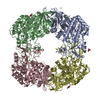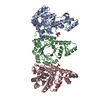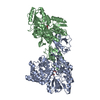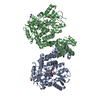+ Open data
Open data
- Basic information
Basic information
| Entry | Database: PDB / ID: 6k5p | ||||||
|---|---|---|---|---|---|---|---|
| Title | Structure of mosquito-larvicidal Binary toxin receptor, Cqm1 | ||||||
 Components Components | Binary toxin receptor protein | ||||||
 Keywords Keywords | PROTEIN BINDING / Amylomaltase / GH13_17 subfamily / Receptor for BinAB toxin / Cqm1 | ||||||
| Function / homology |  Function and homology information Function and homology informationalpha-glucosidase / carbohydrate metabolic process / metal ion binding / membrane Similarity search - Function | ||||||
| Biological species |  Culex quinquefasciatus (southern house mosquito) Culex quinquefasciatus (southern house mosquito) | ||||||
| Method |  X-RAY DIFFRACTION / X-RAY DIFFRACTION /  SYNCHROTRON / SYNCHROTRON /  MOLECULAR REPLACEMENT / Resolution: 1.805 Å MOLECULAR REPLACEMENT / Resolution: 1.805 Å | ||||||
 Authors Authors | Kumar, V. / Sharma, M. | ||||||
 Citation Citation |  Journal: Int.J.Biol.Macromol. / Year: 2019 Journal: Int.J.Biol.Macromol. / Year: 2019Title: Crystal structure of BinAB toxin receptor (Cqm1) protein and molecular dynamics simulations reveal the role of unique Ca(II) ion. Authors: Sharma, M. / Kumar, V. #1:  Journal: Acta Crystallogr F Struct Biol Commun / Year: 2018 Journal: Acta Crystallogr F Struct Biol Commun / Year: 2018Title: Mosquito-larvicidal binary toxin receptor protein (Cqm1): crystallization and X-ray crystallographic analysis. Authors: Sharma, M. / Lakshmi, A. / Gupta, G.D. / Kumar, V. #2:  Journal: Insect Biochem. Mol. Biol. / Year: 2018 Journal: Insect Biochem. Mol. Biol. / Year: 2018Title: Receptor protein of Lysinibacillus sphaericus mosquito-larvicidal toxin displays amylomaltase activity. Authors: Sharma, M. / Gupta, G.D. / Kumar, V. | ||||||
| History |
|
- Structure visualization
Structure visualization
| Structure viewer | Molecule:  Molmil Molmil Jmol/JSmol Jmol/JSmol |
|---|
- Downloads & links
Downloads & links
- Download
Download
| PDBx/mmCIF format |  6k5p.cif.gz 6k5p.cif.gz | 939.6 KB | Display |  PDBx/mmCIF format PDBx/mmCIF format |
|---|---|---|---|---|
| PDB format |  pdb6k5p.ent.gz pdb6k5p.ent.gz | 776.7 KB | Display |  PDB format PDB format |
| PDBx/mmJSON format |  6k5p.json.gz 6k5p.json.gz | Tree view |  PDBx/mmJSON format PDBx/mmJSON format | |
| Others |  Other downloads Other downloads |
-Validation report
| Arichive directory |  https://data.pdbj.org/pub/pdb/validation_reports/k5/6k5p https://data.pdbj.org/pub/pdb/validation_reports/k5/6k5p ftp://data.pdbj.org/pub/pdb/validation_reports/k5/6k5p ftp://data.pdbj.org/pub/pdb/validation_reports/k5/6k5p | HTTPS FTP |
|---|
-Related structure data
| Related structure data |  3wy1S S: Starting model for refinement |
|---|---|
| Similar structure data |
- Links
Links
- Assembly
Assembly
| Deposited unit | 
| ||||||||
|---|---|---|---|---|---|---|---|---|---|
| 1 | 
| ||||||||
| 2 | 
| ||||||||
| 3 |
| ||||||||
| Unit cell |
| ||||||||
| Details | Authors state that the protein 6K5P does not exist as tetramer, |
- Components
Components
-Protein , 1 types, 4 molecules ABCD
| #1: Protein | Mass: 64744.902 Da / Num. of mol.: 4 Source method: isolated from a genetically manipulated source Source: (gene. exp.)  Culex quinquefasciatus (southern house mosquito) Culex quinquefasciatus (southern house mosquito)Gene: Cqm1 / Production host:  |
|---|
-Non-polymers , 6 types, 2333 molecules 










| #2: Chemical | ChemComp-MG / #3: Chemical | ChemComp-CD / #4: Chemical | ChemComp-CA / #5: Chemical | ChemComp-ACT / #6: Chemical | #7: Water | ChemComp-HOH / | |
|---|
-Details
| Sequence details | THE SEQUENCE OF THIS PROTEIN WAS NOT AVAILABLE AT THE UNIPROT KNOWLEDGEBASE DATABASE (UNIPROTKB) AT ...THE SEQUENCE OF THIS PROTEIN WAS NOT AVAILABLE AT THE UNIPROT KNOWLEDGEB |
|---|
-Experimental details
-Experiment
| Experiment | Method:  X-RAY DIFFRACTION / Number of used crystals: 1 X-RAY DIFFRACTION / Number of used crystals: 1 |
|---|
- Sample preparation
Sample preparation
| Crystal | Density Matthews: 2.24 Å3/Da / Density % sol: 48.18 % |
|---|---|
| Crystal grow | Temperature: 295 K / Method: vapor diffusion, sitting drop / pH: 7.5 Details: 5mM CoCl2, 5mM CdCl2, 5mM MgCl2, 5mM NiCl2, 0.1mM HEPES pH 7.5, 12% PEG 3350 |
-Data collection
| Diffraction | Mean temperature: 100 K / Serial crystal experiment: N |
|---|---|
| Diffraction source | Source:  SYNCHROTRON / Site: SYNCHROTRON / Site:  RRCAT INDUS-2 RRCAT INDUS-2  / Beamline: PX-BL21 / Wavelength: 0.9795 Å / Beamline: PX-BL21 / Wavelength: 0.9795 Å |
| Detector | Type: MAR scanner 345 mm plate / Detector: IMAGE PLATE / Date: Oct 3, 2018 |
| Radiation | Monochromator: Double Crystal Monochromator / Protocol: SINGLE WAVELENGTH / Monochromatic (M) / Laue (L): M / Scattering type: x-ray |
| Radiation wavelength | Wavelength: 0.9795 Å / Relative weight: 1 |
| Reflection | Resolution: 1.805→39.23 Å / Num. obs: 201511 / % possible obs: 93.9 % / Redundancy: 7.1 % / CC1/2: 0.998 / Rmerge(I) obs: 0.072 / Rpim(I) all: 0.044 / Rrim(I) all: 0.09 / Net I/σ(I): 14.4 |
| Reflection shell | Resolution: 1.805→1.9 Å / Redundancy: 7.3 % / Rmerge(I) obs: 0.532 / Mean I/σ(I) obs: 2.8 / Num. unique obs: 31009 / CC1/2: 0.929 / Rpim(I) all: 0.318 / Rrim(I) all: 0.621 / % possible all: 99.9 |
- Processing
Processing
| Software |
| ||||||||||||||||||||||||||||||||||||||||
|---|---|---|---|---|---|---|---|---|---|---|---|---|---|---|---|---|---|---|---|---|---|---|---|---|---|---|---|---|---|---|---|---|---|---|---|---|---|---|---|---|---|
| Refinement | Method to determine structure:  MOLECULAR REPLACEMENT MOLECULAR REPLACEMENTStarting model: 3WY1 Resolution: 1.805→29.828 Å / SU ML: 0.2 / Cross valid method: FREE R-VALUE / σ(F): 1.34 / Phase error: 24.38 Details: Metal-ligand distance were not restrained. SF FILE CONTAINS FRIEDEL PAIRS UNDER I/F_MINUS AND I/F_PLUS COLUMNS. Data at 1.9A was used for obtaining initial phases by MRSAD method. High ...Details: Metal-ligand distance were not restrained. SF FILE CONTAINS FRIEDEL PAIRS UNDER I/F_MINUS AND I/F_PLUS COLUMNS. Data at 1.9A was used for obtaining initial phases by MRSAD method. High resolution data acquired at 0.9795A was used for structure refinement.
| ||||||||||||||||||||||||||||||||||||||||
| Solvent computation | Shrinkage radii: 0.9 Å / VDW probe radii: 1.11 Å | ||||||||||||||||||||||||||||||||||||||||
| Refinement step | Cycle: LAST / Resolution: 1.805→29.828 Å
| ||||||||||||||||||||||||||||||||||||||||
| Refine LS restraints |
| ||||||||||||||||||||||||||||||||||||||||
| LS refinement shell | Resolution: 1.805→1.823 Å
| ||||||||||||||||||||||||||||||||||||||||
| Refinement TLS params. | Method: refined / Origin x: -17.6037 Å / Origin y: -1.0327 Å / Origin z: 74.8901 Å
| ||||||||||||||||||||||||||||||||||||||||
| Refinement TLS group | Selection details: all |
 Movie
Movie Controller
Controller











 PDBj
PDBj







